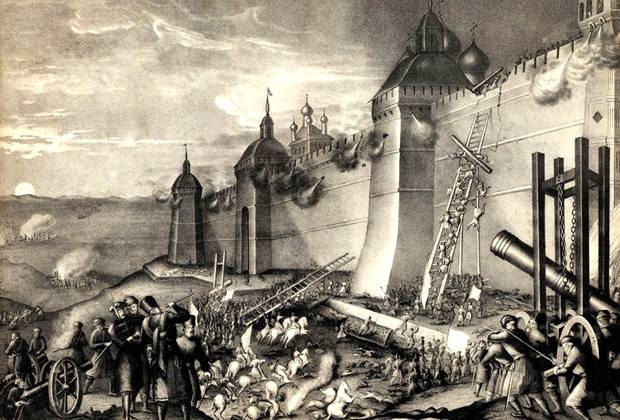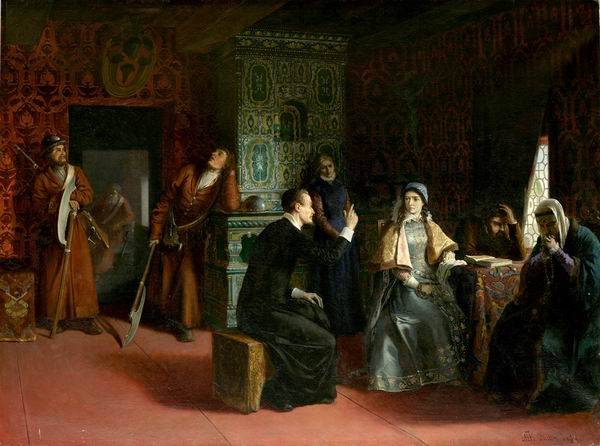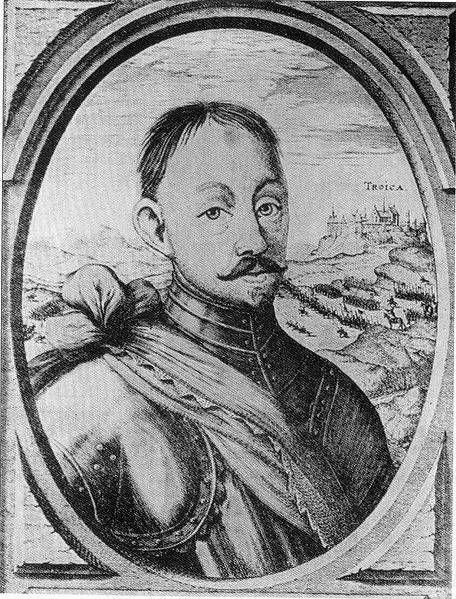How the Poles divided Russia

Siege of Trinity Lavra in 1608. Lithograph of 1852
Marina Mnishek and the impostor
The Rzeczpospolita government at first did not take False Dmitry II seriously. In vain the "Starodub thief" sought to conclude an alliance treaty with Sigismund. The Polish government doubted the impostor's success.
On the other hand, the king did not have the resources and money for a serious war with Russia. The Commonwealth was exhausted by internal squabbles.
However, the impostor's easy victories changed Sigismund's opinion. The Polish king ordered the occupation of Chernigov and Novgorod-Seversky. These plans did not meet with the support of the ruling elite. The great crown hetman Stanislav Zholkiewski noted the army's unpreparedness for war. The king postponed the invasion.
But with his permission, the large tycoon Jan Peter Sapega recruited a large detachment and invaded the Russian state. In August 1608, Sapega crossed the border and captured Vyazma.
Meanwhile, a Russian-Polish peace was signed in Moscow. The peace treaty turned out to be a piece of paper as soon as Sapieha's detachment crossed the border. But Vasily Shuisky has already freed the Mnishek family, including Marina Mnishek (the wife of the first impostor). Old Mnishek took an oath that he would never recognize the new impostor as his next, and they would leave the boundaries of the Russian state.
Mnishek lied blatantly. In a secret correspondence with the king, he convinced him that "Tsar Dmitry" was saved. And you need to provide him with military assistance.
People who knew the first impostor well tried to warn Marina Mnishek against the "mistake". However, the brilliance of the Russian "cap of Monomakh" eclipsed her eyes. She wanted to be the Russian queen. False Dmitry II was informed that his "wife" would soon come to him.
The boys under escort went to the border, but moved very slowly, along the deaf country roads. All this time, they got in touch with the impostor. At the very border, Yuri Mnishek left the Russian convoy, which was immediately attacked by the Tushins.
Together with Sapega Mnisheki arrived in the Tushino region in September. Pan Yuri planned to become hetman (commander-in-chief) and head of the "king" government. However, Hetman Ruzhinsky ruined his plans.
The bargaining went on for several days. Then the father sold his daughter for a lump sum. "Dmitry" promised the master a million zlotys. True, False Dmitry could become the actual spouse of Marina only after seizing the throne and paying money. The impostor visited the camp of Sapieha.
The appearance of the "husband" disgusted Marina, but for the sake of the Russian throne she closed her eyes to his shortcomings. Soon the "queen" solemnly drove into Tushino and began to play the role of a loving wife. Contrary to her father's wishes, she became the impostor's unmarried cohabitant. The angry pan left the impostor's camp and returned to Poland.
This comedy could not deceive the Polish gentry and mercenaries who knew False Dmitry I well. The second impostor was his pale shadow.
But the common people were delighted. The news of the arrival of the "queen" spread throughout the country.
The flames of the civil war flared up with renewed vigor. In Pskov, the townspeople arrested the governor and recognized the power of "Dmitry". Unrest began again in the Volga region. The Tushins occupied the cities of Moscow without a fight, the power of False Dmitry was recognized by Pereyaslavl-Zalessky, Yaroslavl, Kostroma, Balakhna and Vologda. With the help of the city's lower classes, the Tushins occupied Vladimir, Rostov, Suzdal, Murom and Arzamas. Detachments of townspeople, peasants, slaves and Cossacks were in a hurry from all over the country to Tushino.

Artist M.P. Klodt. Marina Mnishek and her father Jerzy Mnishek in custody in Yaroslavl (1883)
Tushino camp
Ataman Ivan Zarutsky became the leader of the Russian part of the Tushino camp.
In some ways, the fate of Zarutsky resembled that of Bolotnikov. Born into a bourgeois family, as a boy he was captured by the Crimean Tatars. Was in captivity, was able to escape, moved to the Don Cossacks. Together with the donors he served "Tsar Dmitry", fought on the side of Bolotnikov. When the tsarist army laid siege to Tula, Zarutskiy was sent in search of the "tsar" to bring reinforcements to Bolotnikov.
Ataman discovered the "king" in Starodub. Under the leadership of Zarutsky there was a great force - thousands of Donets and Cossacks. However, he did not quarrel with the Poles, he preferred to come to an agreement. Contemporaries noted his cunning.
In Tushino, Zarutsky became the head of the Cossack order and promptly suppressed all signs of dissatisfaction with the "tsar" and the Poles among the Cossacks and men. The ataman got along well with the Tushino Boyar Duma. A free Cossack was erected in the boyar, granted patrimonies and estates. In fact, he was also the commander-in-chief under the "king". Pan Rozhinsky (Ruzhinsky) spent most of his time drinking. Therefore, Zarutsky was in charge of intelligence, posted patrols and received reinforcements.
At the same time, new detachments from Lithuania and Poland arrived in Tushino. Rumors of the impostor's successes spread throughout the Commonwealth. The gentry and adventurers of all stripes were in a hurry to take part in the robbery of Russia, which was considered fabulously rich.
The leaders were Ruzhinsky and Sapega. They completely controlled the "king" and divided Russia into spheres of influence. Pan Ruzhinsky was in charge in Tushino and in the southern cities. Sapega planned to capture the treasures of the Trinity and the city north of Moscow.
Mercenaries and adventurers despised the "king", but they needed his name to cover up their crimes. Ruzhinsky's detachments cut off Moscow from the southern and western cities. Sapega laid siege to the Trinity-Sergius Monastery (How Polish and Russian "thieves" tried to capture the treasures of the Trinity), took control of the road to Zamoskovye and to the north.
There were quite a few Russian boyars in the Tushino camp. They felt great there. The leading positions were occupied by the Romanovs and Saltykovs. Rostov Metropolitan Filaret (Fyodor Romanov) was first taken prisoner by the Tushinites, but quickly got used to it. The impostor returned him to the rank of patriarch.
Under Filaret, all the relatives who "flew" to Tushino quickly rallied - the Troekurovs, Sitskys, Cherkasskys. The Boyar Duma was headed by the boyar Mikhailo Saltykov and Prince Dmitry Trubetskoy. Many noblemen also fled to the Tushino "tsar" in search of wealth and honor (positions).
The impostor generously granted deserters and issued certificates of ownership of land. Often, generosity was only on paper, False Dmitry did not have free money (all the seized wealth was quickly “mastered by Poles and other thieves). Therefore, deceived in their hopes, the fugitives returned to the capital.
It happened that the "Tushino flights" several times passed from Shuisky to "Dmitry" and back. Tsar Vasily tried not to quarrel with "strong people" and did not execute "flights", used their information for his own purposes and exposing the impostor. They did not stand on ceremony with ordinary thieves, they drowned them at night in an ice-hole.
When winter came, Tushins walked around the neighborhood, chose the richest villages and expelled their residents from their homes. The houses were dismantled and transported to Tushino.
Tushino thieves took away everything they wanted from the population. True, initially the people still believed "Dmitry". The impostor was generous with promises. He promised to free him from royal duties, to grant various liberties.
So, the residents of Yaroslavl sent a large treasury and carts with food to Tushino. They promised to send a thousand horsemen. But their ardor quickly faded away when first they were robbed by the soldiers of Ruzhinsky, and then by Sapieha.

Jan Pyotr Sapega (1569-1611)
Battle of Nizhny Novgorod
Having occupied Yaroslavl, the Tushins tried to seize the Lower in order to break through to the Lower Volga and control the entire great river. They established themselves in Balakhna, near Nizhny Novgorod.
Non-Russian peoples rebelled in the Volga region. Nizhniy was surrounded, communication with Moscow was lost. The city did not give up. Power passed to the Zemsky Soviet (the legacy of Ivan the Terrible is the Russian “horizontal” of power). The council was attended by Voivode Repnin, nobles, elders and zemstvo people. The council relied on the posad community.
Soon Nizhniy became the nucleus of the resistance of "Tushinskaya Russia". Nizhny Novgorod defeated the advancing Tushins, recaptured Balakhna and cleared the district of thieves. Their successes alarmed Tushino, a detachment under the command of Prince Vyazemsky was sent against Nizhny.
The people of Nizhny Novgorod were not afraid of the enemy, they again defeated the Tushins. Vyazemsky was taken prisoner and hanged in the city. At the beginning of 1609, the Nizhny Novgorodians recaptured Murom and achieved the transition to their side of Vladimir. But there were not enough forces for the further offensive.
Moscow at that time had a connection only with the Ryazan region. Food was transported along the Kolomna road and reinforcements arrived. In the fall of 1608, Tushino thieves twice tried to capture Kolomna in order to completely blockade the capital, deprive it of aid and supplies.
The local voivode Pushkin asked the Moscow government for support. Voivode Dmitry Pozharsky was sent to his aid (he was in Moscow at that time). He defeated the Tushins near Kolomna.
Mutiny in Moscow
On February 25, 1609, Shuisky's opponents tried to organize a coup. A crowd of armed people entered the Kremlin and burst into the meeting room of the Boyar Duma.
The rebels demanded to depose the stupid and wicked king. Members of the Duma did not argue with armed people. When the crowd moved from the palace to the square, the boyars fled to the estates.
The rebels captured and beat the Patriarch Hermogenes. The conspirators were unable to provoke the uprising of the capital's posad. The bulk of the townspeople remained indifferent to the uprising.
While the rebels were making noise in the square, Tsar Vasily managed to summon the troops loyal to him from the camp on Khodynka. When the rebels rushed to the royal palace, it was too late. Shuisky shut himself up in the palace and announced that he would not voluntarily give up the table. The crowd began to disperse, troops soon arrived and restored order. Many rebels had to flee to Tushino.
In the spring of 1609, the situation escalated again.
The Tushintsy besieged Kolomna and cut off the only communication in the capital. A terrible famine began (the city was overflowing with refugees). Hundreds of bodies were removed from the streets every day. The starving people gathered at the royal residence and demanded Vasily to their place.
A new conspiracy was organized against Shuisky. They planned to kill him during the Easter celebration. The conspirators counted on the broad support of the nobles and townspeople. Some of the participants in the conspiracy (Buturlin) gave Shuisky all the plans of his opponents. It failed.
Decomposition of the Tushino mill
The successes of the Tushins reached their highest point, but almost immediately a rapid decline began. Tushinskaya Russia did not have a solid foundation. She was torn apart by contradictions. The boyars and nobles had their own interests - to overthrow Shuisky, to take the throne themselves, or to plant a relative, to achieve honor and wealth.
Poles and Lithuanians arrived with the aim of plundering the Russian land, which caused an ever-increasing resistance of the masses. A partisan, popular war against the interventionists began. The Cossacks, for the most part "thieves", also lived by robbery and violence. Nobody took the interests of the peasants into account.
As a result, a huge territory was submitted to the "king", but he could not keep it. It had its own Boyar Duma, orders (central institutions), an army, but there was no normal management and order. In particular, the collection of taxes was in fact a direct robbery of the people.
The impostor had no money to pay for the services of the mercenaries. He gave them letters for feeding and collecting taxes. The Polish lords completely controlled the finances of the Tushino Tsar, his wife and court. The Poles at this time discarded all conventions and disposed of in Russia as in the occupied territory. Robbery, violence and terror.
They did not need estates and ranks. They had real power (power) and used it. The mercenaries only needed gold. They took any goods, provisions and fodder, raped women and girls. Everyone who resisted was killed. Other thieves did the same. A wave of violence flooded the Russian kingdom.
It is clear that the mood of the people began to change. Faith in the "good" king was shaken.
It became obvious that invaders and thieves were behind “Dmitry”. From their own sad experience (burned villages, girls raped and taken into slavery, murdered fathers and brothers, etc.) people became convinced that the power of the Lithuanian people and Tushino governors brings only death, ruin, violence and hunger.
The Tushins crushed any resistance with terror. The Russian people responded with a national liberation movement.
It is worth remembering that under Tsar Ivan the Terrible, a zemstvo self-government was created. It was this “horizontal” of power that played a decisive role in the fight against invaders, robbers and thieves, in the restoration of the Russian state.
In Vologda, the Tushins did not even hold out for several weeks. Galich and Kostroma, the Dvina land and Pomorie followed Vologda.
In the spring of 1609, the militia cleared the Volga region of thieves. And they threw back Lisovsky's detachment from Yaroslavl.
Information